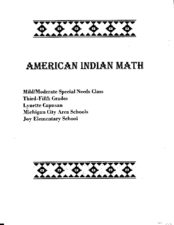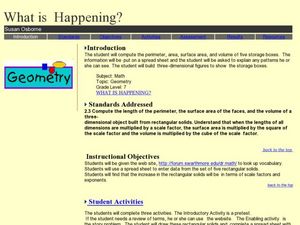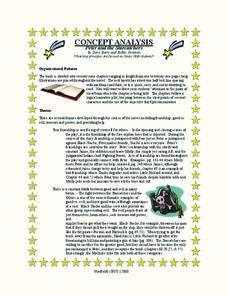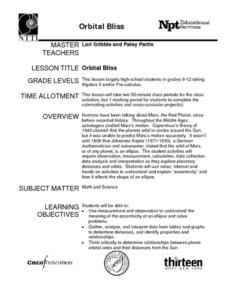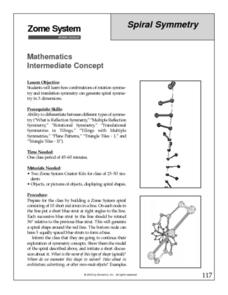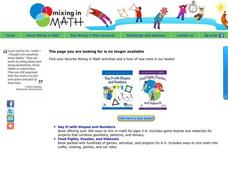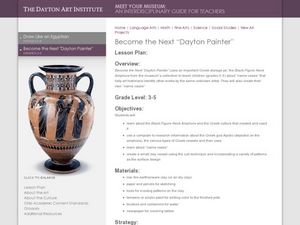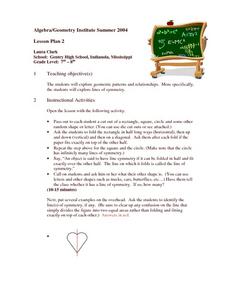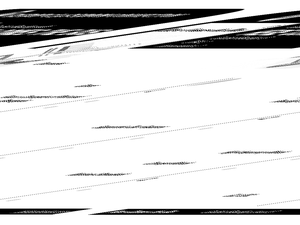Curated OER
What Is It?
You have to love lessons that foster problem solving strategies. This one has upper graders devise and employ their own strategy to solve given problems after they have used classics like guess/check, substitution, make a table, and look...
Curated OER
Molecular Biology and Primate Phylogenetics
Pairs of high school biologists compare amino acid differences in the beta hemoglobin of different primates. They use the information collected to construct a phylogenic tree. Follow-up discussion questions are provided. This is a...
Curated OER
Soccer - Lesson 3 - Dribbling
The most important skill in soccer is dribbling. Most can do a decent job of kicking the ball around, but it takes a lot of practice to get good and make the ball do exactly what you want it to do. So this lesson on dribbling is just one...
Curated OER
Composite Functions and Inverse Functions
In this function worksheet, students complete five lessons all with exercise sets, examples, and definitions, and one set of miscellaneous exercises. The concepts covers include: composite functions, inverse functions, graphs of...
Curated OER
American Indian Math
Upper graders examine Native American culture while practicing mathematical concepts related to patterns and estimation. They will use mental math to add/subtract single digit numbers.
Curated OER
What is Happening?
Review area, perimeter and volume using this lesson. After reviewing key vocabulary relating to these concepts and answering story problems, learners compute the perimeter, area, surface area, and volume of five storage boxes.
Curated OER
Peter and the Starcatchers: Concept Analysis
Are you preparing to teach Peter and the Starcatchers? If so, you'll want to take a look at this analysis of the text, which describes plot and literary elements in-depth and explores potential implications related to diversity and...
Curated OER
The Solar System
Looking for a cross-curricular project for language arts and science? Use this lesson to reinforce knowledge of the Solar System, as well as expository writing skills. Elementary and middle schoolers choose one aspect of the Solar System...
Curated OER
Orbital Bliss
Most young mathematicians are aware that the planets don’t orbit the sun in a circle but rather as an ellipse, but have never studied this interesting feature. This resource looks at the planetary orbits in more detail and helps learners...
Curated OER
Talking About Your Name in Math Terms
Add imagination and creativity to your math lesson. Young mathematicians investigate ways to express their names in mathematical terms. For instance, they can count the number of letters, analyze the geometric shapes of the letters, or...
Curated OER
Spiral Symmetry
Taking the notion of symmetry to the next level, this looks at combining rotation and translation symmetry to build spiral symmetry in three dimensions. Using the Zome modeling system and an instructor’s guidance, geometers try to build...
Curated OER
Tic Tac Toe Do's and Don'ts
Fourth graders listen as the counselor reads statements. They receive a tic-tac-toe worksheet and complete it with two different color crayons. Students look at the overhead projector and check their tic-tac-toe game card. They discuss...
Curated OER
Write Your Own Haiku
Use this resource as a quick and easy way to discuss the characteristics of haikus. Learners identify the number of syllables required for each line, and talk about the subject matter. The one thing missing from this presentation is an...
Curated OER
Picturing the Successful Student
Sixth graders work in small groups to identify the characteristics of a successful learner. They identify characteristics that think are most helpful for them. Students answer the question: What does a successful student look like?
Curated OER
Writing Process-- Revision and Editing
As guided practice, class members work together to revise a model persuasive paragraph. Then they practice independently with their own writing. The included rubric looks at prewriting, drafting, revising, editing, nonfiction text...
Curated OER
Clothes
Let's go shopping! Featuring terms like blue jeans, high heels, and slippers, this ESL presentation would be a good addition to your unit about clothing. Each slide features one item of clothing, a fun illustration, and a short description.
Curated OER
I Spy Shapes
All your students have likely played the age-old game "I Spy," and now you can play it in the classroom! A leader (could be you to start) chooses something in the room with a familiar geometric shape. The class begins asking yes or no...
Curated OER
Flags
First graders investigate flags and their meaning. For this flag lesson, 1st graders explore the flags of states that grow rice. Students understand that flags have meaning and match flags to their states.
Curated OER
Fantastic Fractions
Fourth graders work with fractions using hands on experiences and reasoning skills and use fractions to communicate the idea of a part of a whole.
Curated OER
Dayton Painter
Students explore Greek culture. In this Greek art lesson, students identify Greek art and create their own piece of art. Students view the Black-Figure Neck Amphora and discuss its details. Students then sketch their own art on paper to...
Curated OER
Easy and Artistic Printmaking Using Mixed Media Materials
Students explore printmaking which began with the ancient Chinese who carved seals from stone, inked them and used the seals as identification symbols. They produce a print in this lesson.
Curated OER
Exploring Lines of Symmetry
Students investigate the concept of symmetry. They use cut out shapes that are folded in order to practice identifying the lines of symmetry. The lesson is observed by the teacher working with students for the purpose of scaffolding and...
Curated OER
Guided Reading Lesson: Here Comes the Bus
Students discover basic concepts of print. In this early literacy lesson, students discover basic high frequency words. Students make predictions as they read. Cross-curricular activities provided.
Curated OER
Sudoku Puzzle
For this Sudoku worksheet, students solve a puzzle by filling in the numbers 1-9 so that each number appears only once in each row going across and down and in each block of 9 squares.






